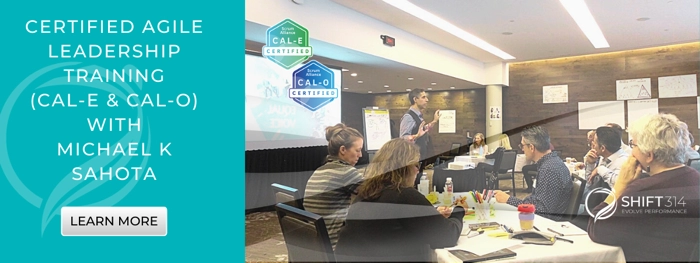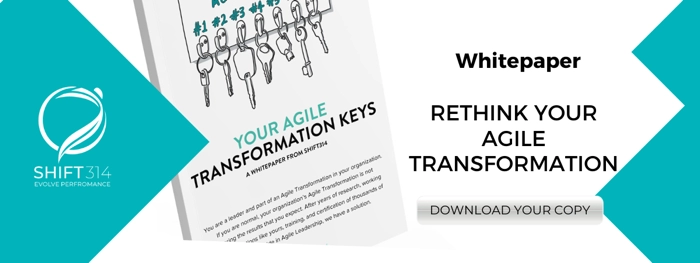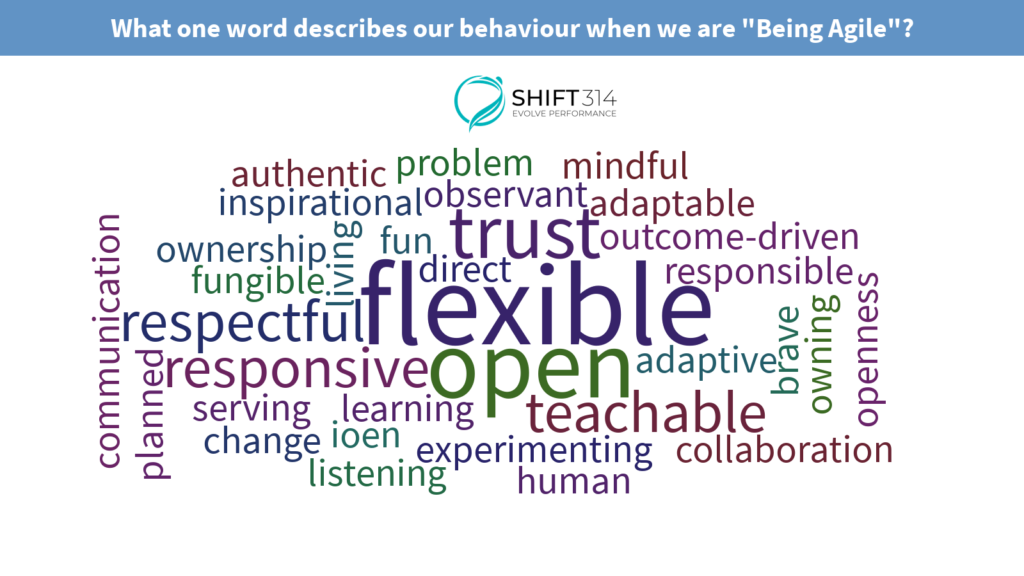In order to create Business Agility through Agile, organizations must not only embrace Agile Processes but also integrate the Agile Mindset. To create an Agile organization, everyone needs to shift to the Agile Mindset. Many teams can make this move with the right environment. Yet, what about the leaders who are creating the environment?
Agile Leadership Gap
It is important that leaders in an Agile organization live the Agile Mindset to unlock the full benefits of Agile. The truth is: most don’t have the Agile Mindset. That’s what we call the Agile Leadership Gap. Leaders don’t have the shift in mindset and the “being” and “doing” needed to model an Agile way of work.
Agile training alone doesn’t give people this mindset shift. Giving managers, product owners, Scrum masters, and executives Scrum training isn’t going to help them achieve the Agile Mindset.
There is a huge gap in giving leaders the mindset shift that they need to model the Agile Mindset. And it’s virtually impossible for organizational leaders to make their organization more Agile without a shift in mindset.
This is the leadership gap.

What Is the Agile Mindset?
The Agile Mindset. It’s a mysterious, elusive concept. People have heard about it, people want it, people understand it’s essential for success. But what on earth is it?
In order to understand the Agile Mindset, we have to look back at the Agile Manifesto. The Agile Manifesto contains three essential items–what I call the essence of Agile:
- Culture of Learning
- Valuing People
- Responding to Change
Let’s look at each of these in-depth.
Culture of Learning
Many people have heard about this shift from a fixed mindset to a learning mindset (or a “growth mindset” as it’s called in the work of Carol Dweck). In order to have a learning mindset, people must be open to learning, considering new ideas, and discovering new information.

However, we discovered that in order to truly be successful with Agile, leaders need something beyond even the traditional learning mindset. We have discovered a deeper, new type of mindset that unlocks the Agile Mindset, which we call the Evolutionary Mindset.
In an evolutionary mindset, we’re not just open to learning, we are open to learning about ourselves. We’re ready to examine things like:
- Our behaviors
- Our ego
- Our consciousness
- How we’re showing up
- The damage our leadership behaviors could be causing to others
- How to take ownership of our mistakes
Having the courage to take an honest look at ourselves and use it as a catalyst for growth, using the evolutionary mindset, is what we call Evolutionary Leadership. This is what the manifesto is pointing to. And this is how to be successful with Agile.
Developing the mindset of an evolutionary leader is actually a very practical step. If you have a team of seven people and you want them to collaborate, guess what? People’s egos and conditioned behavior patterns are going to get in the way. To truly have collaboration–to truly have people working together, to get results, and to successfully build the extraordinary–is for people to be committed to evolving themselves.
This inner shift is an essential part of the Agile Mindset.
Valuing People
The first line of the Agile Manifesto states: “Values individuals and interactions over process and tools.” What that’s really about when we simplify it is, people over process.
If we think about a high performance culture, it’s about highly engaged, motivated people. Agile, through the manifesto, is pointing us to what the mindset is about. It’s about people who are focused on showing up as their best selves, collaborating with others to create amazing products and very successful organizations. Agile is a guide to create amazing workplaces, to transform the world of work.
However, the transformation to a “people first” mindset doesn’t just happen because we see value in it.
Many of us unconsciously react in ways that aren’t people first–and we may not even be aware of it. We might have an emotional outburst or get irritated with people. A lot of us get attached to the way things are done. Oftentimes, we use processes and rules to create stability and safety for ourselves. Those are all ways that we’re not acting people first, and thus not realizing the potential of agile.
Putting people first means an actual inner shift in our being.
Since we’re highly conditioned to have typically reactionary behaviors that do not put people first, there’s a lot of reshaping needed internally for how we show up. That is the mindset shift, which will manifest as a shift in our behaviors that allow us to put people over process.

Responding to Change
The third part that’s essential is the phrase, “Responding to change over following a plan.” What does it really mean to respond to change? Responding to change requires an inner shift in our being. If done effectively, we may create plans, yet we are able to adapt when the situation calls for it.
We understand that most organizations are highly complex systems and that the best outcomes often arise when we let go of our plans. We let go of our need for certainty and we embrace what’s happening around us.
This third point is saying, “Hey, do you notice you’re more successful when you respond to what’s happening around you instead of following your plan?” Are you getting stuck pushing your agenda, or pushing what you think an organization needs? Are you getting frustrated, angry and resistant when plans change?
That responding to change over following a plan creates better results is a simple observation–it could even be called common sense. And yet it requires a shift to an evolved mindset for us as human beings to feel comfortable letting go of our plans.
How Do You Know if You’re Living the Agile Mindset?
How do you know if you’re living the Agile Mindset? That is, how do you know you are showing up as an evolutionary leader?
The very simple test is to look behind you. Are there people following you? Are there people reaching out to you to ask for your help and your guidance? That’s how you know.

The Agile Mindset is a Shift in Consciousness (Not a Skill or Technique)
What we’re speaking about is a transmission. It’s an essential attribute of our being. There’s no technique that will give you the Agile Mindset. The skills and techniques are there to help you create self-awareness so you can see where you’re living the Agile Mindset and where you’re not. But, ultimately, this is an inner shift in your being, a transmission.
We’ve all had these experiences where we’re around people who feel inspiring and motivating–there’s something different about them we can’t quite put our finger on.
That’s what it will feel like as you evolve the Agile Mindset in yourself. People won’t quite know what it is, but you’ll be showing up in a very different way that will lead to completely different outcomes that may astonish you.

The Agile Mindset is Possible
While this all may seem intimidating, we know it’s fully achievable. We’ve had many of our graduates from around the world report that they’ve seen the shift. They suddenly see people reaching out to them and seeking their advice because they’ve learned how to show up in a new way. They’ve learned how to live the Agile Mindset, so it’s integrated as a living transmission through their actions.

How Can an Organization Develop the Agile Mindset?
Once we put all of this together, the question becomes “How can people get there? How can teams get there? How can our whole organizational system get there?” Let’s dive in.
First, let’s look at how we create Agile teams. Creating Agile teams is not new. If you have an effective Agile coach, they can create teams that work in an Agile way. But in order to create true business agility, we don’t need Agile teams – we need an Agile organization.
In order to create an Agile organization, the organization’s leaders must have an Agile Mindset–which brings us to the great importance of the Agile leadership gap.
How Do We Overcome the Agile Leadership Gap?
How do we overcome the Agile leadership gap? Let’s start by looking at how we help teams achieve an Agile way of working. We know that if we give teams effective training followed by embedded on-the-job mentoring, that over time they can make progress on the journey. The same exact thing is needed for leadership.
Leadership would be more effective with specialized training to understand Agile leadership–how to live and model the mindset to lead a successful Agile transformation. It is important to understand very practically and tangibly how to maintain an Agile culture. They need to understand what specific behaviors and practices will allow them to operate in the way that’s aligned with the Agile Mindset.

Transformation Is Not Delegable
It’s important to note that managers and executives cannot delegate transformation to a transformation team–it simply doesn’t work. As the holders of the power in organization, they are the ones that lead the transformation. They can take a very passive role leading it and not much will happen, or they can take a very active role and see real transformation.
From a Traditional Mindset to an Agile Mindset
Most people in organizations are put into an environment where the system is telling them how to function, essentially programming their mindset. In order to live the Agile Mindset and to show up as evolutionary leaders, we have to overcome the constraints around us.
To be an influential leader of change, one must be able to show up in an evolved way no matter what’s happening around us, no matter the structures and conditioning. Through this shift in our being, we can lead a shift in what’s happening around us.
Practically speaking, this works at a local level by creating a culture bubble in our part of the organization, or by showing up in a way that will inspire and influence others around us at our level and upwards.
That’s really the challenge and the possibility: focusing on our own evolution, whether you’re a team member, executive, manager, product owner, or coach. How are we actually interacting with people? When we see a shift in our interactions, that’s when we’ll be able to say, “I’m living the Agile Mindset.”

Agile Alone Is Insufficient
Real transformation in an organizational system is only possible to the extent that leaders learn and embody the Agile Mindset. So what we’ve discovered is that Agile is insufficient. It’s great at pointing to these three essential items: a culture of learning, valuing people, and responding to change. However, Agile training doesn’t help leaders develop these essential elements, and the mindset shift that goes along with them.
Changing Structures Doesn’t Work Without Changing Mindset
Here’s one of the biggest traps in Agile: people often say, “What structures do I need to change in my organization to create a different outcome?” But changing structures doesn’t work without changing mindset.
There’s no structure that works for everyone. There’s no copy-paste system that you can use. Each organization has its own unique DNA. It is important for leadership to have the skills to create new structures and new ways of working.
This requires leaders who have fully developed inner psychological safety to run experiments. It also requires leaders who have the knowledge and skill to create new structures that are unique and customized to their organization.
This is the type of leadership that forms the foundation of high performance through leading through influence and is based on a dissolved ego. Rethinking Agile requires supporting each leader’s growth so they show up as a more evolved leader. This is what allows a more evolved outcome to happen and creates the shift in organizational performance.

Understanding the Laws of Organizational Dynamics
What we’ve discovered is that Agile is great at pointing to what’s needed, but it’s incomplete. So we created what we call the “laws of organizational dynamics.” It’s an integrated understanding of what’s needed to create success through Agile (and even beyond Agile!). What’s needed to create business agility is what we call Evolutionary Leadership.
What have we learned after decades of studying leadership? It turns out it’s not actually about Agile. It’s something we call Evolutionary Leadership, which is an integrated way of doing and being that reflects a shift in consciousness. It’s a shift in behaviors and inner worldview that creates high performance. That’s why, when we look at the Agile Mindset, it starts with this kernel of Agile, but becomes something much bigger.
Evolutionary Leadership
Put simply, the Agile leadership gap is this: to create a successful leader and Agile environment requires more than just the Agile Mindset. It’s the mindset of an Evolutionary Leader–a broader understanding of what it takes to create business agility and how high-performance organizations truly function.
All of this is achievable. With the right instruction, training, and mentoring, it’s possible for leaders to get there.
This is how we look at creating an Agile Mindset in the organization: ultimately when we look at the root of it, it’s a leadership problem. Without the leaders modeling it, the Agile Mindset can never really be fully embedded in the organization and the full benefits of Agile can never be realized.
Creating Mindset Shift With Technology of Consciousness
The Shift 314 Technology of Consciousness is a technology co-created by myself and Audree Tara Sahota. We took Audree’s 20 years of experience in working with personal growth and transformation, plus my experience of working with organizations creating business success. We put the two together, along with information we’ve learned and evolved by working together.
What we’re sharing with you is the best of the technologies that we have co-created by putting our superpowers together. These technologies allow people to rapidly create a shift in consciousness.
Some people may feel overwhelmed with the idea of shifting mindset and behavior and assume that it’s a lengthy process. In the old modalities, it might have involved 20 years of counseling. Yet now it doesn’t have to be that arduous. We’re talking about very rapid shifts by accessing people’s consciousness directly. By helping people connect in a very deep way to the inner state of their being, we facilitate an experience that creates a lasting change in mindset while shaping new behaviors.
We at Shift 314 hold a transmission of an evolved consciousness. Because we hold that transmission, we can share it and help others on the journey. Because we’ve done our work of personal growth and self-evolution, we can help others on their journey of self-evolution.



